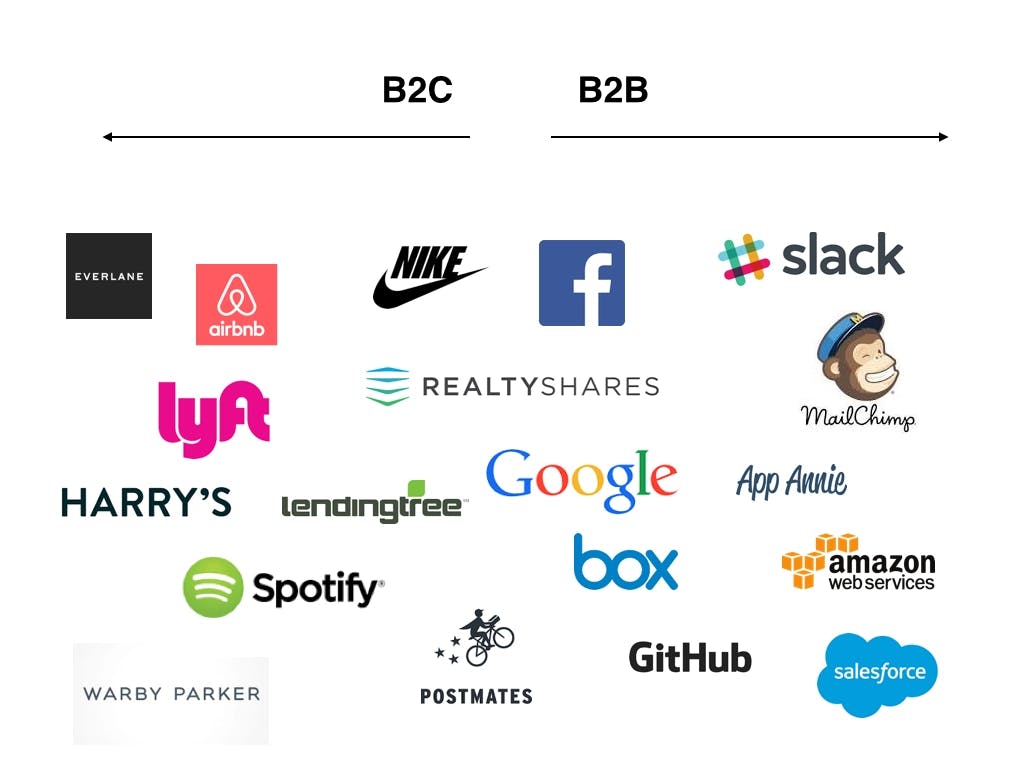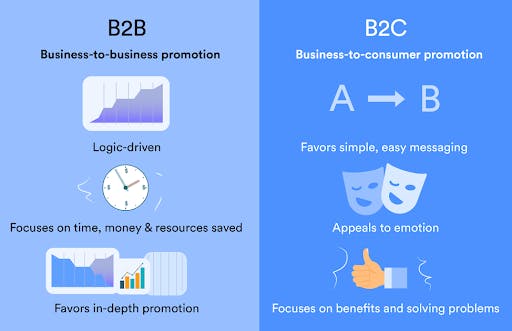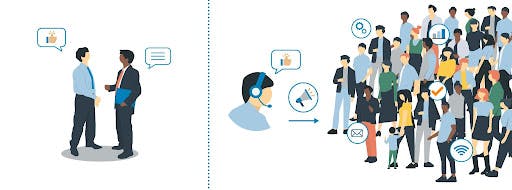B2B vs B2C differences in marketing, sales and customer service
Sep 2nd, 2021

Contents
B2B vs B2C
B2B vs B2C marketing
B2B vs B2C sales
B2B vs B2C customer service
B2B and B2C are not that different
While each company's target audience is unique, there are various methods to categorize them — by industry, geography, age, or specific customer characteristics. One approach to classify firms is based on whether their clients act as retail customers or as business representatives while making a purchase. This article will provide the key differences between these models in marketing, sales and customer support processes. We will consider the decision-making process, target audiences, buying cycle, and other essential aspects.
B2B vs B2C
B2B and B2C are two distinct business models targeted at different types of customer segments: either at businesses or at end consumers. The models have significant differences, which we will describe further in the article. Understanding the fundamental points of the B2B and B2C model and their pros and cons will help you create the most appropriate sales and marketing strategy, improve your customer service and other business operations.
What is B2B?
The term “B2B” stands for “business to business”. B2B refers to the business model in which companies develop and sell the products intended for other firms. There are several ways of business relations between two companies. For example, the business can supply raw material to the company that will make the final product, distribute goods produced by the other company or provide support for various secondary activities. B2B companies usually operate in manufacturing, retail, technology, construction, insurance, healthcare, eCommerce, and telecommunications. Moreover, the supply chain of every industry is based on business-to-business sales.
The common example of B2B transaction often takes place in automobile manufacturing. The car manufacturers buy the electronics, tires, and batteries from vendors and use them in the final product. Thus, when the customers purchase vehicles, they, in fact, buy the parts created by hundreds of different companies from all over the world.
Credit card processing companies widely use the B2B model. General Electric produces not only consumer goods but also supplies parts for various other businesses. Xerox is a well-known brand that provides paper and printing services to other companies.
Online B2B companies release products designed to simplify other organizations’ routine tasks. For example, B2B CRM systems, such as Salesforce, Hubspot, and Pipedrive CRM, allow for managing the existing customer relationships and organizing sales, marketing, and customer support data. ERP systems, such as NetSuite, Odoo, and Microsoft Dynamics 365, are intended for planning and managing everyday activities, including supply chain, production, operations, financials, and other procedures.
B2B SaaS solutions assist organizations in operating more efficiently and save money on human resources. Companies use SaaS software to improve sales, marketing, and customer service and increase revenue. Some of the most popular SaaS B2B products for online businesses include Hubspot, Slack, Dropbox, and Zoom.
What is B2C?
The term “B2C” means “business to consumer” and relates to the procedure of selling the products between the firm and its target customers. According to the B2C model, the consumer receives goods and services directly from the seller, such as customers purchasing clothes at the mall or users subscribing to streaming platforms to watch TV shows at home.
Most businesses employ one of five types of online B2C business strategies to reach out to their customers: direct sales, third party sales, advertising-based, fee-based, and community-based models. The most common model of B2C in the digital world is direct sales. The customers purchase the products from online retailers, such as manufacturers, small businesses, or department store websites.
The other popular model is the model of a third party’s participation. The intermediaries usually do not own the products but connect buyers and sellers. Examples of online intermediaries are the websites like eBay, Etsy, and Expedia.
There are also advertising-based, fee-based, and community-based B2C models. In the advertising-based B2C model, the customers come to the website through digital ads and lots of free and valuable content. An example of the advertising-based model is the Huffington Post, which incorporates advertisements alongside the original content.
With the help of community-based websites, such as social media platforms, the sellers and marketing specialists can advertise products directly to customers.
The fee-based model offers free content in limited quantities and requires payment for access to the website. Major media platforms like New York Times and streaming services like Netflix often employ this approach.

Overall differences between B2B and B2C
The critical difference between B2B and B2C models is the target audience. The clients of B2B companies are businesses that use products and services from B2B businesses to create, improve or support their own product or service. At the same time, B2C firms sell the products directly to the final customers. The other fundamental differences are pricing models and customer support.
Pricing. B2C companies usually offer the standard pricing structure for all customers. Thus, the prices may change only depending on discounts or sales. B2B model, in contrast, provides various tiers of discounts based on the frequency of purchases and order volumes.
Customer support. B2B firms attract new wholesale customers through account managers who provide assistance and strive to enhance sales. In turn, B2C organizations mainly respond to clients’ frequent questions and resolve issues via customer support agents.
Customized vs standardized products. B2B companies normally launch more complex and customized products to meet the requirements of each business. On the other hand, B2C organizations are focused on releasing standardized products with a clear product positioning to satisfy the demands of the group of target customers.
B2B vs B2C marketing
B2B and B2C marketing have several similarities, but there are also some important differences that we will consider further in this section. They include the target audience, buying process, and approaches to content creation.
Logic vs emotions. The most significant difference between B2B and B2C marketing is the customer motivation for making the purchasing decisions. B2B marketing relies mainly on rational buying behavior, while B2C marketing focuses on purchasing decisions that are more influenced by emotions. B2B marketers describe the product’s features and how they will benefit the target audience. They make the final decision based on logic. B2C marketers try to evoke emotions in their customers by describing the product’s value in plain language and often focusing on how the buyer will feel after the purchase.
Target customers. Essential differences are the target audience and customer relationships. B2B marketers focus their efforts on the small group of decision-makers, such as CEO, founders, or SME directors. B2C marketing specialists usually pay attention directly to consumers or anybody interested in the products or services they are trying to sell. For example, children can persuade their parents to buy them a PlayStation.
Content marketing works well with both B2C and B2C target audiences. B2B customers require educational content like case studies, newsletters, presentations, FAQs, and ebooks. B2C clients are looking for information that resonates with them on a personal level. The content should not necessarily be related to the product, but it must entertain them and pull emotional triggers. Examples of such content are blog posts, website articles, social media stories. When selling products, both of the groups should carefully consider product marketing best practices.
Channels. B2B companies pay more attention to conferences and trade shows, partner marketing, outbound calling or outreach, webinars, industry-specific media, or promotion on online review platforms. B2C organizations are more interested in online and offline retail, direct sales, and extensive physical presence.
Branding and mass advertising. The B2C sector also attaches greater importance to branding, building awareness, mass advertising, and influencer marketing, as opposed to B2B.

B2B vs B2C sales
You cannot apply the same tactics to sell the products to B2B and B2C customers, so it is essential to understand the differences. As in the case of marketing, one of the most considerable differences is the decision-making basis. B2C sales are based on emotions and driven by a perceived need, while B2B sales are rational and well-planned.
Price disparities. Average purchase spend in B2C is usually much lower than in B2B. It is a common reason B2B consumers invest more time examining options before making a decision. At the same time, B2C product prices can vary from extremely low to extremely high. B2C customers regularly buy products instantly, but when it comes to purchasing higher-priced items, they look for more information and read reviews.
Sales cycle. B2B companies often require a longer sales process as they frequently need more time for lead nurturing. They also require several points of contact. Before buying the product, B2B decision-makers analyze how it may benefit their brand in generating income. B2C buyers, on the contrary, concentrate efforts on recognizing the issues they may experience during the awareness stage. They examine whether a specific product suits their needs. However, B2C customers can make a purchase even from the first point of contact.
Acquisition costs. The cost of customer acquisition in B2B sales is higher in most cases. The increased expenses paid by B2B clients often compensate for the expenses on acquisition. B2C sales have lower acquisition costs per customer because of the shorter sales cycle, impulsive purchases, and word-of-mouth referrals.
Buying process. B2C customers typically purchase products guided by recommendations from relatives or friends. Their purchasing decisions are commonly quick and impulsive. B2B buying cycle is complex and takes more time. Before purchasing the product, B2B decision-makers should involve several departments and pass through many stages.

B2B vs B2C customer service
Customer support applies the same principles for all types of companies, both B2B and B2C: the company should address the customers’ problems quickly and effectively. However, despite similar fundamentals, the customer service of B2B and B2C companies have several crucial differences.
The complexity of the issues. Customer service issues in the B2B sector are more complex and require longer to resolve compared to the B2C. This is because B2B customer service processes generally involve various departments and a large number of people to provide the best answers and solutions.
A number of customers. B2B firms usually have a smaller number of customers. However, as the products of B2B companies are more complex and expensive, the relationship with the customers is more valuable for the organizations in the B2B sector. Therefore, the issues that may arise in the communication between a B2B company and its client might have a more significant financial impact in comparison to those in the B2C sector.
Several points of contact. When the B2C client requires assistance from the customer support service, it is a single individual who bought the product. On the other hand, customer service of the B2B model involves a large number of people from different departments who will try to resolve the issue at once. In this case, the company should understand the whole picture to provide the best solution.
The duration of the interaction. B2C customers come for quick and straightforward responses. The relationship with B2C clients is often superficial, as the customer sees the support as faceless company representatives. Business relationships in the B2B sector are more profound and long-lasting. B2B companies face the high risks of losing a smaller number of customers and losing revenue accordingly. Due to this reason, the key to success is to involve the account managers who will understand the needs of B2B clients and find the individual approach to each client.

B2B and B2C are not that different
While there are many distinctions between B2B and B2C companies, it's vital to understand that they are not that different. Both sectors require a customer-focused sales process, superior customer service, and a high-quality client experience. To make a sale, you must gain the trust of both groups and then focus on addressing the customers’ issues.
The sales process of B2B and B2C companies follows the same scenario. At first, you need to generate awareness, then create an emotional connection and build trust in the mind of the potential buyer, then provide excellent onboarding and customer service during and after the purchase to make sure you succeed in attracting and retaining a customer. It is critical to remember that the customer journey does not end after completing the buying process. It continues after the purchase, so make sure to keep your customer satisfied, willing to return, and recommend you to others.
